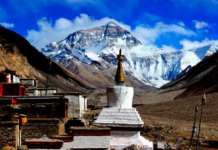Nestled between the majestic peaks of the Himalayas and only a few hours’ drive from Kathmandu, the Langtang Valley Trek is one of Nepal’s most rewarding and accessible trekking adventures. Often called the “Valley of Glaciers,” Langtang offers a breathtaking combination of mountain scenery, cultural encounters, and pristine natural beauty.
Though less famous than the Everest and Annapurna regions, Langtang Valley is no less spectacular — making it a perfect destination for those seeking a quieter, more authentic Himalayan experience.
Introduction to Langtang Valley
The Langtang Valley lies just north of Kathmandu, bordering Tibet, and forms part of the Langtang National Park, Nepal’s first Himalayan national park established in 1976. The region is home to diverse flora and fauna, ancient monasteries, and the warm, welcoming Tamang and Sherpa communities.
At its heart lies Kyanjin Gompa (3,870 meters) — a beautiful village surrounded by snow-capped peaks and serene glaciers. The journey to reach it, the Langtang Valley Trek, is an experience of profound beauty and cultural depth.
Why Choose the Langtang Valley Trek?
The Langtang Valley Trek combines adventure, tranquility, and culture in perfect balance. Here’s why it’s one of Nepal’s most beloved trails:
- Close to Kathmandu: Unlike other major trekking regions, Langtang is just a 6–7-hour drive from the capital — no flights needed.
- Authentic Local Culture: You’ll experience the traditional lifestyle of the Tamang and Sherpa people, whose roots trace back to Tibetan heritage.
- Incredible Scenery: The trail offers stunning views of Langtang Lirung (7,227 m), Ganesh Himal, and the surrounding Himalayan giants.
- Less Crowded: Compared to the busier Everest and Annapurna treks, Langtang remains peaceful and unspoiled.
- Wildlife and Nature: Langtang National Park is home to red pandas, Himalayan black bears, musk deer, and various species of pheasants.
The Trail at a Glance
The Langtang Valley Trek typically takes 7 to 10 days, depending on the itinerary and pace. The route follows the Langtang River upstream through lush forests, bamboo groves, alpine meadows, and traditional villages before reaching Kyanjin Gompa.
Along the way, trekkers experience dramatic changes in landscape, altitude, and culture — from subtropical forests to rugged highlands framed by towering peaks.
Detailed Itinerary: Langtang Valley Trek (10 Days)
Here’s a sample 10-day itinerary for the Langtang Valley Trek:
Day 1: Arrival in Kathmandu (1,400 m)
Arrive in Nepal’s capital and prepare for your trek. Spend the evening exploring the bustling streets of Thamel and adjusting to the local atmosphere.
Day 2: Drive from Kathmandu to Syabrubesi (1,470 m)
A scenic 6–7-hour drive takes you along winding mountain roads to Syabrubesi, the starting point of the trek. Enjoy your first glimpse of the Langtang Himal range and rest for the night in a teahouse.
Day 3: Trek to Lama Hotel (2,480 m)
The trail ascends through forests of oak, rhododendron, and bamboo, where you might spot langurs and red pandas. Follow the Langtang River to reach Lama Hotel, a peaceful village nestled in the forest.
Day 4: Lama Hotel to Langtang Village (3,430 m)
As you climb higher, the vegetation thins, and snow-capped peaks appear in the distance. Passing through small Tamang villages, you’ll reach Langtang Village, which was tragically destroyed in the 2015 earthquake and has since been lovingly rebuilt.
Day 5: Langtang to Kyanjin Gompa (3,870 m)
This is one of the most beautiful days of the trek. You’ll walk through yak pastures and across wooden bridges before reaching Kyanjin Gompa, the spiritual heart of the valley. The village is surrounded by towering mountains — a perfect place to relax and explore.
Day 6: Acclimatization and Exploration Day
Take a day to explore the area. You can hike to Kyanjin Ri (4,773 m) or Tserko Ri (4,984 m) for panoramic views of Langtang Lirung, Dorje Lakpa, and the glaciers below. Many consider this sunrise hike one of the highlights of the entire journey.
Day 7: Trek Back to Lama Hotel
Descend along the same route, retracing your steps through Langtang Village and the forested valley.
Day 8: Trek to Syabrubesi
Continue your descent to Syabrubesi, where the trek officially ends. Celebrate your journey with a hearty meal and reflect on your adventure.
Day 9: Drive Back to Kathmandu
Return to Kathmandu by private jeep or local bus. Enjoy a hot shower, rest, or explore the city’s heritage sites.
Day 10: Departure or Optional City Tour
Depending on your schedule, you can visit Pashupatinath Temple, Boudhanath Stupa, or Durbar Square before your departure.
Best Time for the Langtang Valley Trek
The best seasons for the Langtang Valley Trek are:
- Spring (March to May): Rhododendrons bloom across the hillsides, and the weather is mild with clear skies.
- Autumn (September to November): Ideal trekking conditions — stable weather, warm days, and excellent visibility.
- Winter (December to February): Cold but peaceful, offering solitude and crisp mountain views.
- Monsoon (June to August): Lush landscapes but heavy rain and leeches make trekking challenging.
Accommodation and Food
Teahouses along the Langtang Valley Trek provide comfortable lodging and warm hospitality. Rooms are simple, usually with twin beds and shared bathrooms.
Meals include traditional Nepali dal bhat (rice and lentils), as well as soups, noodles, pancakes, and tea. In Kyanjin Gompa, don’t miss tasting the local yak cheese, made in the nearby cheese factory that dates back to Swiss collaboration in the 1950s.
Permits Required
To enter the Langtang region, trekkers need:
- Langtang National Park Entry Permit
- TIMS Card (Trekkers’ Information Management System)
Both can be obtained in Kathmandu through trekking agencies or the Nepal Tourism Board.
Difficulty Level and Preparation
The Langtang Valley Trek is considered moderate, suitable for beginners with a reasonable fitness level. The maximum altitude (around 4,984 m at Tserko Ri) requires gradual acclimatization, but there are no technical climbing sections.
Preparation Tips:
- Do regular hiking and cardio exercises before the trek.
- Carry a good pair of trekking boots and layered clothing.
- Walk at a steady pace and stay hydrated to prevent altitude sickness.
Culture and People of Langtang
The Langtang region is home to the Tamang and Sherpa communities, who share close cultural ties with Tibet. Trekkers can visit centuries-old Buddhist monasteries, chortens, and mani walls decorated with sacred inscriptions.
Local people are known for their warmth, resilience, and devotion to their traditions. After the devastating earthquake in 2015, many villages were rebuilt with the help of international and local efforts, symbolizing the strength and spirit of the community.
Flora and Fauna
Langtang National Park boasts remarkable biodiversity. Lower elevations feature oak, pine, and rhododendron forests, while higher altitudes host alpine meadows and glaciers. Trekkers might encounter Himalayan tahr, red pandas, snow leopards (rarely seen), and a wide range of bird species.
In spring, the hillsides come alive with colorful wildflowers, creating a painter’s dream against the snow-white backdrop of the Himalayas.
Tips for an Unforgettable Langtang Experience
- Hire a local guide or porter to support the community and enhance your cultural experience.
- Respect local customs — always walk clockwise around stupas and mani walls.
- Carry a refillable water bottle and water purification tablets to reduce plastic waste.
- Start early each morning to enjoy peaceful trails and avoid afternoon clouds.
- Bring a power bank or solar charger, as electricity can be limited in higher villages.
Conclusion: The Magic of the Langtang Valley Trek
The Langtang Valley Trek may not have the fame of Everest or Annapurna, but its charm lies in its serenity, intimacy, and cultural richness. It’s a journey where snow-capped peaks meet warm smiles, where every sunrise feels sacred, and where nature whispers its timeless stories.
From the forests of Syabrubesi to the glaciers of Kyanjin Gompa, the Langtang Valley offers an unforgettable blend of beauty, peace, and adventure — a true hidden gem of the Himalayas.
For travelers seeking authenticity, breathtaking views, and connection with mountain life, the Langtang Valley Trek is an experience beyond compare — one that will stay in your heart long after the trail ends.




